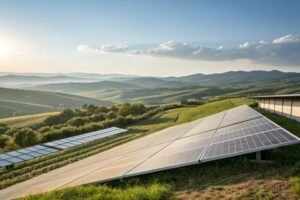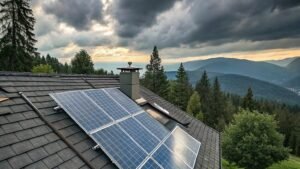Temperature Coefficient of Solar Panels: A Key Efficiency Metric
•
Why do solar panels produce less power on hot summer days? The answer lies in their temperature coefficient - a critical but often overlooked performance specification.
The temperature coefficient measures how much a solar panel's efficiency drops as temperatures rise, typically ranging from -0.3% to -0.5% per °C above 25°C (77°F).
While most focus on wattage ratings, understanding temperature effects reveals why panels perform differently in Arizona versus Alaska - and how to select the right technology for your climate.
What Is the Temperature Coefficient and Why Does It Matter?
Ever wonder why solar output dips during heatwaves? The temperature coefficient explains this phenomenon and helps predict real-world performance.
A panel's temperature coefficient indicates its power loss per degree Celsius above 25°C, with premium panels maintaining better efficiency in heat (-0.3%/°C vs standard -0.5%/°C).
Understanding Temperature Effects
-
Key Concepts
- Standard test conditions: 25°C cell temperature
- Real-world panels often reach 50-70°C
- Every 1°C above 25°C reduces output
-
Calculation Example
Power Loss = Temperature Coefficient × (Actual Temp - 25°C) Example: -0.4%/°C × (65°C - 25°C) = 16% power loss -
Impact by Climate Climate Type Typical Loss Mitigation Strategies Desert 15-25% High airflow mounting Temperate 8-12% Standard installation Cold 2-5% Ground mounting
Pro Tip: Panel temperature (not air temperature) determines performance - dark roofs can add 15-20°C to ambient temps.
Comparing Temperature Coefficients Among Panel Types
Not all solar panels handle heat equally - how do different technologies compare when temperatures soar?
Monocrystalline panels generally have better temperature coefficients (-0.3% to -0.4%/°C) than polycrystalline (-0.4% to -0.5%/°C), with thin-film performing best in heat (-0.2% to -0.3%/°C).
Technology Performance Breakdown
-
Efficiency Retention Panel Type Temp Coefficient 40°C Above STC Loss Monocrystalline -0.35%/°C 14% Polycrystalline -0.45%/°C 18% Thin-film -0.25%/°C 10% -
Material Advantages
- Monocrystalline: Pure silicon structure
- Thin-film: Amorphous silicon tolerates heat
- Bifacial: Additional cooling from rear side
-
Premium Options
- SunPower: -0.29%/°C
- LG: -0.30%/°C
- Panasonic: -0.32%/°C
Trade-off: While thin-film handles heat best, its lower baseline efficiency (10-13%) often makes mono panels better overall.
How to Choose Solar Panels for Hot Climates
Living in Phoenix or Dubai? These strategies will help maximize your solar investment despite scorching temperatures.
Select panels with low temperature coefficients (-0.3%/°C or better), install with cooling airflow, and consider light-colored mounting surfaces to combat heat-related efficiency losses.
Hot Climate Optimization Guide
-
Panel Selection Criteria
- Temperature coefficient ≤ -0.35%/°C
- 72-cell rather than 60-cell (runs cooler)
- Bifacial models where applicable
-
Installation Best Practices
-
Minimum 6" roof clearance Mounting Type Temp Reduction Standard Baseline Elevated 5-8°C cooler Tracking 8-12°C cooler
-
-
Complementary Technologies
- Microinverters (avoid string losses)
- SolarEdge optimizers
- Active cooling systems (commercial)
Climate Note: In humid heat, prioritize corrosion-resistant frames and connectors along with temperature performance.
Conclusion
Understanding temperature coefficients helps select panels that maintain efficiency in your climate - with smart technology choices and installation methods offsetting heat-related losses by 15-30%.








